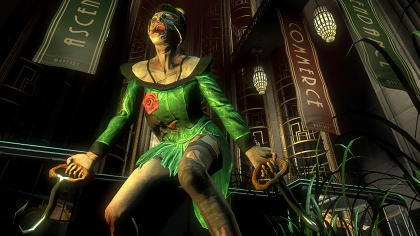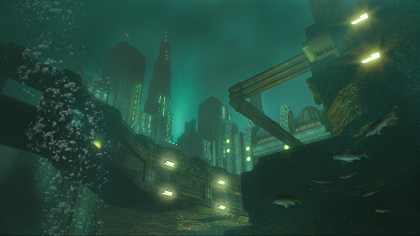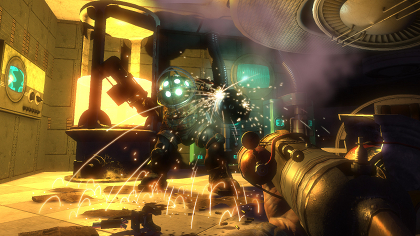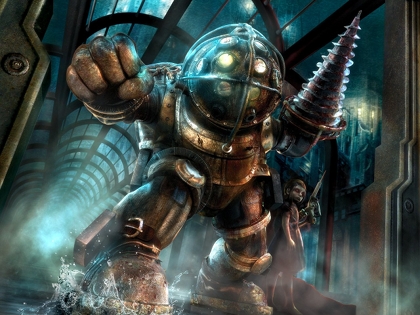I was originally going to include Bioshock in my last post about steampunk games. What ended up happening was that as I wrote about Bioshock’s steampunk aspects, the more I thought about the game’s underlying social/pulp sci-fi themes as opposed to steampunk. The underwater city of Rapture itself falls pretty clearly into mid-century sci-fi with its ambiguously-defined tech and 1940s chic. That said, it’s hard to get more steampunk in look and feel than the terrifying Big Daddies, who would look like members of Captain Nemo’s crew had Nemo also been a mad biomechanical engineer. The plot, ultimately focused around the fear of unregulated scientific achievement, is straight out of mid-century social sci-fi, but it’s not hard to see the city of Rapture, or least what it had been before the game plot began, as a steampunk technologist’s paradise.
Fair warning, there are some minor plot spoilers in here, though I’ll do my best to avoid the major ones. So here we go.
For the three people who haven’t played, or heard of, this game yet, Bioshock is a survival-horror first-person shooter currently available on 360/PS3/PC. Released first in 2007, it takes place in 1960 in the fictional underwater city of Rapture. The city’s founder, Andrew Ryan, wanted to create a sovereign city-state where the enlightened inhabitants (scientists, financiers, and artists) could live to the best of their abilities without any government oversight. The game begins with the protagonist, Jack, as the only survivor of an ocean plane crash, coming to in the immediate aftermath of the crash, floating next to a solitary island. Swimming to the island, Jack finds a lighthouse containing a bathysphere, a pressured steel ball-cockpit, that lets him travel to Rapture (and provides, via a 1940s style cartoon-PSA, he game’s first explanation of the setting). Upon arrival, Jack sees immediately that the idyllic censorship-free utopia is anything but. However, the twisted, genetically-altered, psychotic inhabitants highly recommend the neighborhood. And little girls are able to walk around almost completely without fear, thanks to Rapture’s dedicated watch force from hell, the Big Dadddies.

In my opinion, a central requirement for steampunk is the veneration of 19th-century scientific evolution in the face of technological inadequacy. Steampunk scientists don’t develop new technologies to better solve old problems, they push past the conceivable envelope of industrial-age technologies to solve brand new problems. Nothing in Bioshock epitomizes this more than the Big Daddies. In a city where the average denizen has somewhat nebulous powers like running along the ceiling and surviving major gunshot wounds, the Big Daddies are the most tangible threat to the player, smashing through walls and opponents with ease, demonstrating that for all their genetic superiority, guys who can throw fire aren’t much use against a giant, armored behemoth carrying a grenade launcher in one hand, and a 3-foot-long rotary drill in the other. It’s a triumph of antiquated technology over the science of the next generation.
On the surface, though, Rapture is no steampunk city. Despite taking place in 1960, the city itself is practically a perfect vision of the Roaring Twenties; a knot of Art Deco skyscrapers forms the core of the city, with smaller buildings and less affluent dwellings spreading out from the center. While you may have to look twice to get past the physical changes wrought by gene-splicing, the inhabitants are dressed in simple clothing from the 40s and 50s. Despite its placement under the sea, there is very little tangible technology out in the open; the inner workings of Rapture and the advanced tech that aided in its creation are kept, er, below the surface. Clearly the inhabitants were expected to give no thought to that which provided them sanctuary, and to be satisfied with the minutiae of their own lives, free of that concern.

Digging a little deeper, though, and Rapture’s origins in steampunk-ish thought come to rise. Andrew Ryan is a 19th-century magnate is in every way except era; his primary desire in building Rapture was to create a place where people like him (that part is important) could profit from their life’s work without financial or moral obligation to society or government. Rapture, at least in Ryan’s mind, is a celebration of individualism, and an outright rejection of the communally-determined model of society that he left behind. Naturally, how Rapture’s society evolves and falls apart from the inside, how Ryan’s vision proves inadequate, and the general warning the game provides against rampant scientific development without morality fall are comments on the social development of modern human civilization, and are typical topics for 1920s-1950s social science-fiction, when the world reeled from two world wars, the Great Depression, and even the knowledge of the existence of nuclear weapons. However, an additional effect of the collapse is the exposure of Rapture’s guts; the technology and the people who scrabbled in the dark, tightening screws, fixing utopia whenever it broke down, are the crux of the conflict. Ryan never intended for the workers who followed him to truly part of his vision; he just wanted them to maintain it.

While it is undeniable that the game’s overall message of fear regarding development is closer to social sci-fi, the manner in which its expressed, the conflict that brought Rapture to its knees, is thematically akin to a steampunk revolution; the secret technological potential of the city is exposed for all to see. Does this philosophical development make the game “steampunk”? Or in the end, is it just par for the course for mid-century social sci-fi, and the steampunk aspects are really just there for flavor?
Bioshock is available for the 360, PS3, PC (via both disk and direct download), and, newly, Mac OS X.
David Pucik is a certified scuba diver, and is pretty sure that 3-foot-long rotary drills and creepy little girls are not standard diving equipment. However, just like scuba diving, it’s always advisable to keep breathing when playing video games.











I think immediately of Bioshock when I think Steampunk games. It has a lot, certainly, to do with aesthetic of the bathysphere/Big Daddies/etc… but it’s also the “megalomaniac/science run amok” mindset that authors like Wells & Verne addressed pretty early on in the SF field.
The politics/social commentary of the game is so overt that I feel almost as if it was the flavor. Even though it’s clearly (to me) the aim of the creators to critique the Objectivism of Ayn Rand. Which, conveniently for us steampunks, parallels the industrial age/colonial exploitation of the Victorian age.
Bioshock is not steampunk. For one thing, there is no steam.
Now, I know that people define “steampunk” in a variety of ways, but a common element in all the perspectives I’ve seen is Victoriana and sf-nal extrapolation from early-industrial-era technology and aesthetics.
Bioshock, both in its themes and aesthetics, is firmly rooted in the mid-Twentieth Century, NOT the nineteenth. The architectural styles and fashions of Rapture are clearly modeled on those of the surface world of the 1920s-1940s. The entire plot of the game is an exploration and critique of Objectivist philosophy (definitely a mid-twentieth-century development). Rapture is what would result if John Galt created his ideal society. Andrew Ryan himself is partially based on Ayn Rand. The Big Daddies’ look is taken from pressurized diving suits from the 30s.
It’s all very height-of-the-Western-industrial-period, not the least bit “Age of Steam”-y. If we’re going to classify any sf using pre-1970s technology as “steampunk,” the term loses all meaning.
Uhm, did anyone else see the Bioshock costumes at Dragon*Con? Allow me:
Pics
The drill worked!
To say “Andrew Ryan is a 19th-century magnate is in every way except era” outlines exactly what it is that makes Steampunk Steampunk– the Victorian era and adjacent decades, or at least the fascade of the period. Bioshock appeals to steampunks, just as the Rocketeer does, because it contains the paleo-futurism we’re already interested in- this doesn’t make it Steampunk.
Overarching cultural and narrative themes such as megalomaniacs and ‘science run amok’ are what define science fiction as a genre, not just the Victorian side of things.
-C
Has anyone here heard about dieselpunk?
I think that when you try and narrow down definitions of genre, you are excluding much that could be worth looking at. Science Fiction and Fantasy has always been abolut exploring new places(even if its placed in old places), people and things. By trying to Limit what Steampunk is, you limit your perceptions.
Yes, please let me add my voice to the chorus rising to say “No, this is not steampunk.” Steampunk is an adjective used for describing genre-phenomena.
To describe something set well outside the Victorian era, that emulates the retrofuturism of the 1940s and 1950s as opposed to, say, the 1890s, and does not rely ostensibly on exotic forms of technology available during the steam era as “steampunk” does injustice to the term’s usefulness as a category and a description. It doesn’t limit what steampunk could be – the nature of the classification already does that.
By not calling Bioshock steampunk, we do the genre (and the dieselpunk/pulp genre that Bioshock fits better in) a great credit by not just muddling it with whatever we darn well please.
Although I understand why many people might come to the conclusion that Bioshock is steampunk, I’m going to have to side with dieselpunk on this one.
I especially agree with A.Wahnsinger.
As long as steampunk is an adjective, it is limited by its definition (given: I realize that definitions may change over time).